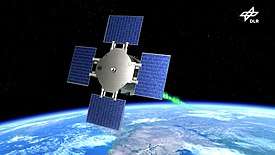EuCROPIS
 Render of the Eu:CROPIS satellite after launch | |
| Mission type | Life sciences research |
|---|---|
| Operator | German Aerospace Center[1] |
| Mission duration | Planned: 1 year [1] |
| Spacecraft properties | |
| Launch mass | 250 kg (550 lb)[1] |
| Dimensions | 1.0m x 1.13m[2] |
| Power | 4 solar arrays (520 W), Li-Ion batteries[1] |
| Start of mission | |
| Launch date | November 2018[3] |
| Rocket | Falcon 9 (Block 5)[3] |
| Launch site | Vandenberg Air Force Base |
| Contractor | SpaceX[4] |
| Orbital parameters | |
| Reference system | Geocentric |
| Regime | Low Earth (SSO) |
| Perigee | 600 km (370 mi) |
| Epoch | Planned[3] |
Eu:CROPIS (Euglena and Combined Regenerative Organic-Food Production in Space) is a German life science satellite developed by the German Aerospace Center and is intended to investigate the possibility of growing plants (specifically tomatoes) in different levels of gravity, such as on the Moon and Mars.[1]
Mission objectives
Primary objective
With water being the only component that has been recycled so far and all other components being extracted and disposed, processing of urine is an issue in human space flight. Eu:CROPIS is intended to examine the possibility of using not only water, but also previously disposed parts to grow fruits and vegetables after proper conversion. The necessary experiments will be executed under varying gravity conditions. Two life support systems (a nitrifying trickle filter system and the single-celled algae Euglena gracilis) within the satellite will be used for producing biomass out of urine. Furthermore, the algae protect the whole system against high levels of ammonia.[2]
The scientific goal is a "seed to seed experiment" while being exposed to gravity levels as on the lunar surface as well as the surface of Mars. Both phases of experimentation will last for six months.
Secondary objective
- PowerCells in Space (Payload 2) intends to measure photosynthesis in algae[5]
- Radiation Measurement in Space (Payload 3) has the goal of collecting data on long-term exposure to cosmic radiation over the course of the space flight[6]
- SCORE (Payload 4) is a technology demonstrator for next generation on-board computing in hardware and software developed by the DLR Institure of Space Systems. It is complemented by a set of three cameras that are commanded via SCORE.[7]
Satellite characteristics
The main satellite payloads are two greenhouses, each maintained as a pressurized closed loop system, therefor simulating the environmental condition of the Moon or Mars. The level of gravity on the Moon (0.16g) and Mars (0.38g) are simulated by rotating the spacecraft's cylindrical body around its longitudinal axis.[1]The experiments on different payloads are realized in different positions within the cylinder.[2]
Onboard instruments
The satellite contains four gyroscopes, two magnetometers and three magnetic torque rods in combination with a single-frequency Phoenix GPS receiver for altitude control. The power for the satellite is provided by an Electrical Power Subsystem, which includes a Lithium-ion battery and four deployable fixed solar arrays delivering an average of 520 W of power.[1]
References
- 1 2 3 4 5 6 7 "Eu:CROPIS". space.skyrocket.de. Retrieved 2018-09-26.
- 1 2 3 "Eu CROPIS - eoPortal Directory - Satellite Missions". directory.eoportal.org. Retrieved 2018-09-26.
- 1 2 3 "UNITED STATES COMMERCIAL ELV LAUNCH MANIFEST". sworld.com.au. 2018-09-26.
- ↑ DLR. "Eu:CROPIS – Greenhouses for the Moon and Mars". DLR Portal. Retrieved 2018-09-26.
- ↑ Kovo, Yael (2015-11-09). "PowerCell". NASA. Retrieved 2018-09-26.
- ↑ Hauslage, Jens; Strauch, Sebastian M.; Eßmann, Olaf; Haag, Ferdinand W. M.; Richter, Peter; Krüger, Julia; Stoltze, Julia; Becker, Ina; Nasir, Adeel (2018-09-26). "Eu:CROPIS – "Euglena gracilis: Combined Regenerative Organic-food Production in Space" - A Space Experiment Testing Biological Life Support Systems Under Lunar And Martian Gravity". Microgravity Science and Technology. doi:10.1007/s12217-018-9654-1. ISSN 0938-0108.
- ↑ "Food Production in Space - Operating a Greenhouse in Low Earth Orbit (PDF)". nasaspaceflight.com. 2016-05-20. Retrieved 2018-09-26.